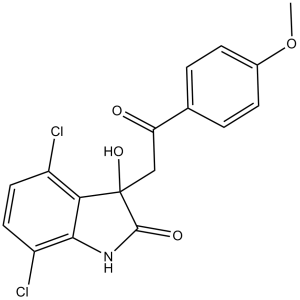YK-4-279 (YK-4279; YK4279; YK4-279; YK 4-279) is a potent inhibitor of EWS-FLI1 binding to RNA helicase A (RHA) with potential anticancer activity. It blocks the interactions between RHA and ES-FLI1 proteins. In a transgenic mouse model, YK-4-279 effectively counteracts the leukemia caused by EWS-FLI1. Targeting the oncogene EWS-FLI1, YK-4-279 exhibits specificity. By preventing EWS-FLI1 from interacting with RHA in TC32 cells that have EWS-FLI1 present, YK-4-279 reduces the amount of cyclin D. Additionally, YK-4-279 induces apoptosis and selectively inhibits the growth of ESFT cells. Additionally, YK-4-279 reduces cell motility and invasion by blocking the biological activity of ERG and ETV1 in fusion-positive prostate cancer cells.
Physicochemical Properties
| Molecular Formula | C17H13CL2NO4 | |
| Molecular Weight | 366.20 | |
| Exact Mass | 365.022 | |
| Elemental Analysis | C, 55.76; H, 3.58; Cl, 19.36; N, 3.83; O, 17.48 | |
| CAS # | 1037184-44-3 | |
| Related CAS # |
|
|
| PubChem CID | 44632017 | |
| Appearance | White solid powder | |
| Density | 1.5±0.1 g/cm3 | |
| Boiling Point | 608.9±55.0 °C at 760 mmHg | |
| Melting Point | 149-151℃ | |
| Flash Point | 322.1±31.5 °C | |
| Vapour Pressure | 0.0±1.8 mmHg at 25°C | |
| Index of Refraction | 1.631 | |
| LogP | 3.03 | |
| Hydrogen Bond Donor Count | 2 | |
| Hydrogen Bond Acceptor Count | 4 | |
| Rotatable Bond Count | 4 | |
| Heavy Atom Count | 24 | |
| Complexity | 509 | |
| Defined Atom Stereocenter Count | 0 | |
| SMILES | ClC1C([H])=C([H])C(=C2C=1C(C(N2[H])=O)(C([H])([H])C(C1C([H])=C([H])C(=C([H])C=1[H])OC([H])([H])[H])=O)O[H])Cl |
|
| InChi Key | HLXSCTYHLQHQDJ-UHFFFAOYSA-N | |
| InChi Code | InChI=1S/C17H13Cl2NO4/c1-24-10-4-2-9(3-5-10)13(21)8-17(23)14-11(18)6-7-12(19)15(14)20-16(17)22/h2-7,23H,8H2,1H3,(H,20,22) | |
| Chemical Name | 4,7-dichloro-3-hydroxy-3-[2-(4-methoxyphenyl)-2-oxoethyl]-1H-indol-2-one | |
| Synonyms |
|
|
| HS Tariff Code | 2934.99.9001 | |
| Storage |
Powder-20°C 3 years 4°C 2 years In solvent -80°C 6 months -20°C 1 month |
|
| Shipping Condition | Room temperature (This product is stable at ambient temperature for a few days during ordinary shipping and time spent in Customs) |
Biological Activity
| Targets | TC32 ( IC50 = 0.94 µM ); TC71 ( IC50 = 1.83 µM ); RDES ( IC50 = 1.03 µM ); SKES ( IC50 = 0.33 µM ); MMH-ES-1 ( IC50 = 0.94 µM ); STA-ET 7.2 ( IC50 = 0.60 µM ); A4573 ( IC50 = 1.46 µM ); PC3 ( IC50 = 4.95 µM ); MCF7 ( IC50 = 22.82 µM ); MDA-MB-231 ( IC50 = 0.82 µM ); PANC1 ( IC50 = 1.514 µM ); ASPC1 ( IC50 = 14.28 µM ) | ||
| ln Vitro |
|
||
| ln Vivo |
|
||
| Cell Assay |
Cell Line: TC32, ES925, GUES1, TC71, A673, A4573, CHP100, PANC1, ASP1, MCF-7, MDA-MB-231, PC-3, HFK and HEC cell lines Concentration: 3-30 µM Incubation Time: 72 h Result: Inhibited cell growth with IC50s of 900 nM, 1 μM and 8 μM for TC32, ES925 and GUES1 cells, respectively. |
||
| Animal Protocol |
|
||
| References |
[1]. Nat Med . 2009 Jul;15(7):750-6. [2]. PLoS One . 2011 Apr 29;6(4):e19343. [3]. PLoS One . 2014 Dec 5;9(12):e114260. |
||
| Additional Infomation | 4,7-dichloro-3-hydroxy-3-[2-(4-methoxyphenyl)-2-oxoethyl]-1H-indol-2-one is an aromatic ketone. |
Solubility Data
| Solubility (In Vitro) |
|
|||
| Solubility (In Vivo) |
Solubility in Formulation 1: ≥ 2.5 mg/mL (6.83 mM) (saturation unknown) in 10% DMSO + 40% PEG300 + 5% Tween80 + 45% Saline (add these co-solvents sequentially from left to right, and one by one), clear solution. For example, if 1 mL of working solution is to be prepared, you can add 100 μL of 25.0 mg/mL clear DMSO stock solution to 400 μL PEG300 and mix evenly; then add 50 μL Tween-80 to the above solution and mix evenly; then add 450 μL normal saline to adjust the volume to 1 mL. Preparation of saline: Dissolve 0.9 g of sodium chloride in 100 mL ddH₂ O to obtain a clear solution. Solubility in Formulation 2: ≥ 2.5 mg/mL (6.83 mM) (saturation unknown) in 10% DMSO + 90% (20% SBE-β-CD in Saline) (add these co-solvents sequentially from left to right, and one by one), clear solution. For example, if 1 mL of working solution is to be prepared, you can add 100 μL of 25.0 mg/mL clear DMSO stock solution to 900 μL of 20% SBE-β-CD physiological saline solution and mix evenly. Preparation of 20% SBE-β-CD in Saline (4°C,1 week): Dissolve 2 g SBE-β-CD in 10 mL saline to obtain a clear solution. Solubility in Formulation 3: ≥ 2.5 mg/mL (6.83 mM) (saturation unknown) in 10% DMSO + 90% Corn Oil (add these co-solvents sequentially from left to right, and one by one), clear solution. For example, if 1 mL of working solution is to be prepared, you can add 100 μL of 25.0 mg/mL clear DMSO stock solution to 900 μL of corn oil and mix evenly. (Please use freshly prepared in vivo formulations for optimal results.) |
| Preparing Stock Solutions | 1 mg | 5 mg | 10 mg | |
| 1 mM | 2.7307 mL | 13.6537 mL | 27.3075 mL | |
| 5 mM | 0.5461 mL | 2.7307 mL | 5.4615 mL | |
| 10 mM | 0.2731 mL | 1.3654 mL | 2.7307 mL |
